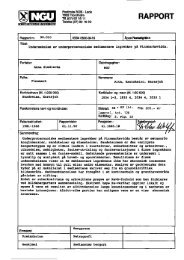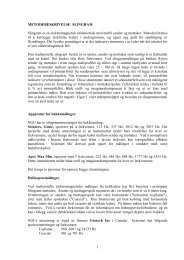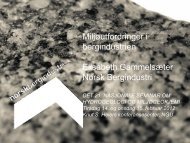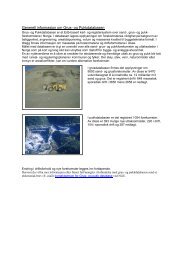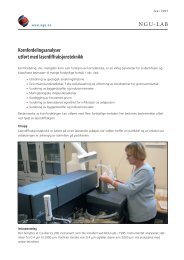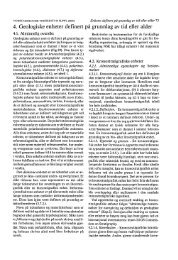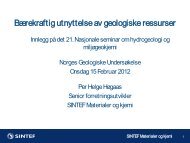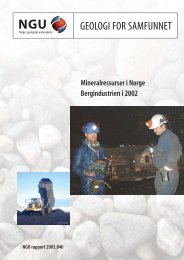National inventory and database of ancient stone quarry ... - NGU
National inventory and database of ancient stone quarry ... - NGU
National inventory and database of ancient stone quarry ... - NGU
Create successful ePaper yourself
Turn your PDF publications into a flip-book with our unique Google optimized e-Paper software.
GeoloGical Survey <strong>of</strong> Norway Special publicatioN n 12<br />
<strong>National</strong> <strong>inventory</strong> <strong>and</strong> <strong>database</strong><br />
<strong>of</strong> <strong>ancient</strong> <strong>stone</strong> <strong>quarry</strong> l<strong>and</strong>scapes<br />
in Egypt<br />
Azza Shawarby, Elshaimaa Fathy, Marwa Sadek, Naguib Amin,<br />
Rawda Yousri <strong>and</strong> Sara Kayser<br />
Supreme Council <strong>of</strong> Antiquities (SCA), Zamalek, Cairo, Egypt.<br />
E-mail: ashawarby@eais.org.eg<br />
The Egyptian Antiquities Information System (EAIS) started as an Egyptian–Finnish project <strong>and</strong> finally<br />
developed to be a fully functioning GIS Centre <strong>of</strong> Excellence within the Supreme Council <strong>of</strong><br />
Antiquities (SCA). Over the course <strong>of</strong> seven years it succeeded in analysing, identifying <strong>and</strong> <strong>of</strong>fering<br />
solutions, which supports the digital documentation <strong>of</strong> various Egyptian heritages. Throughout the<br />
QuarryScapes project it was generally concluded that <strong>of</strong> all the Egyptian heritages the <strong>quarry</strong> l<strong>and</strong>scapes<br />
are among the least recognised <strong>and</strong> appreciated. The present paper will briefly highlight<br />
some <strong>of</strong> the problems identified during our research activities, in addition to our modest efforts for<br />
the digital documentation <strong>of</strong> the Egyptian <strong>quarry</strong> l<strong>and</strong>scapes. Our activities concluded with a belief<br />
that we have succeeded in drawing the attention <strong>of</strong> the Egyptian administration to such an important<br />
element <strong>of</strong> the Egyptian heritage. However, extreme efforts need to be exerted to initiate a<br />
concrete protection <strong>and</strong> preservation strategy, plans <strong>and</strong> practices. Efforts should primarily focus on<br />
changing how the quarries are being regarded through conducting awareness-raising campaigns<br />
that target concerned institutions (SCA, Governorates <strong>and</strong> <strong>quarry</strong>ing authorities), specialists in the<br />
field <strong>of</strong> archaeology, as well as inhabitants living adjacent to the sites. The Egyptian administration,<br />
will face extreme challenges attempting to resolve the current problem. Consequently, setting <strong>and</strong><br />
conducting national <strong>and</strong> international projects similar to the QuarryScapes project <strong>and</strong> encouraging<br />
research in the field <strong>of</strong> <strong>ancient</strong> <strong>quarry</strong>ing, should be encouraged as part <strong>of</strong> the long-term sustainable<br />
strategy.<br />
Shawarby, a., fathy, e., Sadek, m., amin, N., yousri, r. <strong>and</strong> Kayser, S. (2009) <strong>National</strong> <strong>inventory</strong> <strong>and</strong> <strong>database</strong> <strong>of</strong> <strong>ancient</strong> <strong>stone</strong><br />
<strong>quarry</strong> l<strong>and</strong>scapes in egypt. In abu-Jaber, N., bloxam, e.G., Degryse, p. <strong>and</strong> Heldal, t. (eds.) QuarryScapes: <strong>ancient</strong> <strong>stone</strong> <strong>quarry</strong><br />
l<strong>and</strong>scapes in the Eastern Mediterranean, Geological Survey <strong>of</strong> Norway Special publication,12, pp. 155–163.<br />
155
n azza SHawarby, elSHaimaa fatHy, marwa SaDeK, NaGuib amiN, rawDa youSri aND Sara KaySer<br />
Introduction<br />
Throughout Egyptian history, <strong>stone</strong> has<br />
been a key element in the monumental<br />
heritage, from the Predynastic Period to<br />
the Islamic. The exploitation <strong>of</strong> such resources<br />
has created <strong>quarry</strong> l<strong>and</strong>scapes all<br />
over the country in a variety <strong>of</strong> rock types.<br />
In order to best manage <strong>and</strong> protect these<br />
areas, it is vital first to get an overview <strong>of</strong><br />
where they are located, <strong>and</strong> then identify<br />
when they were quarried, in what condition<br />
they are today <strong>and</strong> what legal measures<br />
can be taken to protect them. In this<br />
sense, a vital part <strong>of</strong> the QuarryScapes<br />
project was to design <strong>and</strong> produce a comprehensive<br />
map <strong>and</strong> <strong>database</strong> <strong>of</strong> <strong>ancient</strong><br />
Egyptian <strong>quarry</strong> l<strong>and</strong>scapes to facilitate<br />
general l<strong>and</strong>-use management <strong>and</strong> awareness<br />
raising. The aim <strong>of</strong> the present paper<br />
is to present the results <strong>of</strong> the activities<br />
undertaken over the course <strong>of</strong> our involvement<br />
in the QuarryScapes project.<br />
Several regional surveys <strong>of</strong> <strong>ancient</strong><br />
quarries have been conducted in Egypt,<br />
<strong>and</strong> <strong>of</strong> these the work by Pr<strong>of</strong>essor James<br />
A. Harrell is so far the most comprehensive.<br />
The <strong>database</strong> developed during the<br />
QuarryScapes project largely builds on<br />
Harrell’s work (Harrell <strong>and</strong> Storemyr<br />
2009), but with contributions also from<br />
other researchers (particularly Klemm<br />
<strong>and</strong> Klemm 1993, 2008) <strong>and</strong> from several<br />
case studies in the QuarryScapes<br />
project. In particular, the risk assessment<br />
<strong>of</strong> <strong>ancient</strong> Egyptian quarries as presented<br />
by Storemyr et al. (2007) <strong>and</strong> Storemyr<br />
(2009) has been important for evaluating<br />
the conservation status <strong>and</strong> threats to<br />
the <strong>quarry</strong> l<strong>and</strong>scapes. The technical <strong>and</strong><br />
practical aspects <strong>of</strong> constructing a spatial<br />
<strong>database</strong> that can contribute in implementing<br />
measures on a national scale for<br />
future conservation <strong>of</strong> the sites will be<br />
discussed in the following sections. An<br />
overview <strong>of</strong> the rock types <strong>and</strong> quarries is<br />
given in Harrell <strong>and</strong> Storemyr (2009).<br />
Egyptian quarries<br />
<strong>and</strong> the use <strong>of</strong> GIS<br />
A Geographical Information System<br />
(GIS) is a system <strong>of</strong> computer s<strong>of</strong>tware,<br />
1 Egypt risk <strong>and</strong> monitoring.<br />
156<br />
hardware, data <strong>and</strong> personnel to help<br />
manipulate, analyse <strong>and</strong> present information<br />
that is tied to spatial location.<br />
With a GIS, information (attributes)<br />
can be linked to location data, such as<br />
people to addresses, buildings to parcels,<br />
or streets within a network. The information<br />
can then be layered to give a<br />
better underst<strong>and</strong>ing <strong>of</strong> how it all works<br />
together. The combination <strong>of</strong> layers will<br />
vary based on the questions that need to<br />
be answered.<br />
Though the emergence <strong>of</strong> the GIS<br />
technology worldwide can be traced back<br />
to 1960s, its practical implementation<br />
in Egypt has been significant only over<br />
the last two decades. Nevertheless, lack<br />
<strong>of</strong> data, data inconsistency <strong>and</strong> the unwillingness<br />
to share information are still<br />
common limitations to a wider distribution<br />
<strong>of</strong> this technology in the country.<br />
GIS can help planners <strong>and</strong> analysts<br />
‘visualise’ data to better underst<strong>and</strong> patterns<br />
<strong>and</strong> spatial phenomena. In addition,<br />
layers <strong>of</strong> information can be displayed<br />
through the use <strong>of</strong> GIS s<strong>of</strong>tware,<br />
which eventually helps in establishing<br />
a spatial relation among various sets <strong>of</strong><br />
data. Each set <strong>of</strong> data can be displayed<br />
in the form <strong>of</strong> points, lines or areas.<br />
Points, which are used in the <strong>inventory</strong><br />
<strong>of</strong> Egypt’s <strong>National</strong> Quarries, are used to<br />
represent phenomena that have a specific<br />
location, such as mines, trees <strong>and</strong> houses.<br />
The most important concept involved in<br />
the use <strong>of</strong> GIS is associating, or ’attaching‘,<br />
attribute data to a specially referenced<br />
base map. The organisation <strong>of</strong> the<br />
attribute data is a very crucial stage towards<br />
conducting advanced analysis.<br />
The availability <strong>of</strong> a solid information<br />
base is not only essential for data analysis.<br />
The challenges arising from climatic<br />
changes, global warming <strong>and</strong> all other environmental<br />
hazards, <strong>and</strong> the fragile state<br />
<strong>of</strong> the archaeological heritage, require an<br />
immediate development <strong>of</strong> ’Crisis Management<br />
Plans (CMP)’. The preparation<br />
<strong>of</strong> accurate CMPs will mainly rely on the<br />
presence <strong>of</strong> updated information, e.g.,<br />
precise location, current status, state <strong>of</strong><br />
preservation (to set priorities for interven-<br />
tion). In the above context, the output <strong>of</strong><br />
this activity, the <strong>National</strong> Digital Map <strong>of</strong><br />
Ancient Stone Quarry L<strong>and</strong>scapes in Egypt,<br />
was designed to specifically address similar<br />
problems.<br />
However, the <strong>National</strong> Digital Map<br />
layer cannot alone be used for analysis.<br />
Other layers, relevant to the case analysed,<br />
need to be available to be able to conduct<br />
the analysis procedure. As an example, if a<br />
question arises on the possibility <strong>of</strong> using<br />
some <strong>of</strong> the <strong>ancient</strong> quarries for modern<br />
<strong>quarry</strong>ing activities not only the current<br />
status <strong>of</strong> each <strong>of</strong> the <strong>ancient</strong> quarries is<br />
enough, other basic information (layers)<br />
must also be available; such as roads, railways<br />
<strong>and</strong> urban agglomerations.<br />
Data capture<br />
Through his painstaking research <strong>and</strong><br />
field work, Pr<strong>of</strong>essor James A. Harrell<br />
has located nearly 200 <strong>ancient</strong> quarries<br />
in Egypt <strong>and</strong> Sudan, <strong>and</strong> the result <strong>of</strong> his<br />
work was selected as the base for the creation<br />
<strong>of</strong> the <strong>National</strong> Quarry Map. The<br />
information was categorised in the form<br />
<strong>of</strong> 3 tables, covering the main groups <strong>of</strong><br />
rocks (Hard<strong>stone</strong>s, S<strong>of</strong>t<strong>stone</strong>s <strong>and</strong> Gem<strong>stone</strong>s)<br />
<strong>and</strong> including the location <strong>of</strong> the<br />
quarries in degrees (d) <strong>and</strong> minutes (m)<br />
for north latitude <strong>and</strong> east longitude. In<br />
addition, <strong>quarry</strong> age, sometimes tentative,<br />
was also included in the tables (see<br />
Figure 1).<br />
The tables were subsequently extracted<br />
into Excel sheets <strong>and</strong> imported inside<br />
ESRI ArcView, <strong>and</strong> the coordinates were<br />
used to create the point shapefile (version<br />
#1). The ID_EAIS, added to the attribute<br />
table <strong>of</strong> the point shapefile (version<br />
#1), was created by overlaying the Egyptian<br />
administrative division shapefile,<br />
<strong>and</strong> based on the geographical location<br />
<strong>of</strong> the <strong>quarry</strong> site.<br />
ID_EAIS consists <strong>of</strong> three sections: q<br />
(for <strong>quarry</strong>), xx (two digits <strong>of</strong> the governorate<br />
code) <strong>and</strong> the last section is zzzz<br />
(four-digit serial number) i.e., qxxzzzz<br />
(see Figure 2).<br />
Based on the version #1 shapefile, the
Figure1. Illustration <strong>of</strong> the categorisation methodology used to convert Harrell’s tables into excel sheets.<br />
Figure 2. Sample <strong>of</strong> the <strong>National</strong> Quarry Map shapefile where the ID_EAIS is used for labels.<br />
NatioNal iNveNtory aND DatabaSe <strong>of</strong> aNcieNt StoNe <strong>quarry</strong> laNDScapeS iN eGypt n<br />
activities <strong>of</strong> Work Package 5 in the QuarryScapes<br />
project 1 developed the ’Extended<br />
Database; Egypt quarries WGS84 Database<br />
Application‘ which brings together<br />
the information in the shapefile along<br />
with the data attained from other sources<br />
<strong>and</strong> through QuarryScapes research. The<br />
<strong>database</strong> was extracted into an excel sheet<br />
<strong>and</strong> converted into a shapefile (Version<br />
#2); which included the addition <strong>of</strong> several<br />
new quarries, as well as updated data<br />
for the existing quarries. In some cases,<br />
photos <strong>of</strong> samples <strong>of</strong> the rocks for <strong>stone</strong><br />
types were available for the quarries, <strong>and</strong><br />
were linked to the <strong>database</strong>.<br />
The next stage included performing<br />
all necessary research (archaeological,<br />
historical <strong>and</strong> legal) crucial to determine<br />
the actual condition <strong>of</strong> these quarries.<br />
Knowing that the quarries’ legal status<br />
(i.e., how the SCA regards the quarries)<br />
is a vital element for their protection, the<br />
available SCA records were examined<br />
<strong>and</strong> the local inspectorates were contacted<br />
(see below). The outcome <strong>of</strong> the legal<br />
research was summarised in a separate<br />
field named (Ident_Taft), which would<br />
make it possible to visualise quarries in<br />
terms <strong>of</strong> their legal status.<br />
Archaeological <strong>and</strong><br />
historical data<br />
The GIS shapefile was also combined,<br />
based on a common ID, with an archaeological<br />
<strong>database</strong> (see section 3: Database<br />
Enhancement), which contains entries<br />
describing the archaeological features <strong>of</strong><br />
the quarries, the history <strong>of</strong> their use as<br />
well as an analysis <strong>of</strong> the environmental<br />
<strong>and</strong> human risks threatening their preservation.<br />
It indicates where features have<br />
been lost, or are in danger <strong>of</strong> becoming<br />
so, <strong>and</strong> complements the spatial data in<br />
the GIS. This information was retrieved<br />
from available reports <strong>and</strong> articles, as<br />
well as from field research, <strong>and</strong> was integrated<br />
into the site datasheets where it<br />
was reviewed before it was entered into<br />
the <strong>database</strong>.<br />
As mentioned above, the most extensive<br />
list <strong>of</strong> known quarries in Egypt (<strong>and</strong><br />
Nubia) currently available is the result <strong>of</strong><br />
the survey carried out by James Harrell<br />
over the past two decades. As with the<br />
157
n azza SHawarby, elSHaimaa fatHy, marwa SaDeK, NaGuib amiN, rawDa youSri aND Sara KaySer<br />
<strong>quarry</strong> map, his list has been the starting<br />
point for the literature review, <strong>and</strong> data<br />
for the ca. 200 quarries on this list have<br />
been collected from a range <strong>of</strong> sources, including<br />
scientific publications in English,<br />
French, German <strong>and</strong> Arabic, <strong>and</strong> unpublished<br />
reports from the archives <strong>of</strong> the Supreme<br />
Council <strong>of</strong> Antiquities (Table 1).<br />
The results <strong>of</strong> these activities have shown<br />
that in general terms there is an alarming<br />
lack <strong>of</strong> specialised information about <strong>ancient</strong><br />
quarries in Egypt 2 . Nevertheless, a<br />
small number <strong>of</strong> scholars have made extensive<br />
contributions to the knowledge<br />
<strong>of</strong> <strong>ancient</strong> <strong>quarry</strong>ing <strong>and</strong> have surveyed<br />
a larger number <strong>of</strong> sites. It is unfortunate,<br />
however, that the interest among<br />
the great majority <strong>of</strong> scholars seems to<br />
remain low.<br />
The sources reviewed in this study can be<br />
roughly divided into six types:<br />
1. Notes on <strong>ancient</strong> quarries found in<br />
excavation reports/or publications,<br />
which mainly deal with archaeological<br />
features other than quarries; e.g.,<br />
Giza plateau.<br />
2. Comprehensive surveys <strong>of</strong> <strong>ancient</strong><br />
quarries all over Egypt or in selected<br />
areas.<br />
3. Publications dealing entirely with results<br />
<strong>of</strong> work on selected <strong>quarry</strong>/mine<br />
sites.<br />
4. Survey/excavation results provided<br />
directly by the QuarryScapes team.<br />
5. Reports from SCA.<br />
6. Quarry excavation reports.<br />
Extensive research from the first<br />
source (notes on <strong>ancient</strong> quarries) has<br />
on the whole produced limited information<br />
about the quarries. Quite <strong>of</strong>ten<br />
the notes consist <strong>of</strong> brief passages stating<br />
that there are quarries in the vicinity <strong>of</strong><br />
the archaeological site <strong>and</strong> occasionally a<br />
brief mention <strong>of</strong> when <strong>and</strong> for what they<br />
were used. This translates into relatively<br />
sparse data related to a limited number<br />
<strong>of</strong> sites in the <strong>database</strong>. On rare occasions,<br />
however, there are sections in the<br />
archaeological reports dedicated entirely<br />
158<br />
Table 1. Graph which summarises the outcome <strong>of</strong> the archaeological <strong>and</strong> historical literature review.<br />
to surveys <strong>of</strong> nearby quarries. Examples<br />
are Akoris <strong>and</strong> al-Bersheh (Willems<br />
1989). Also, references to quarries are<br />
found in several classical works, including<br />
Petrie (1894), Legrain (1900), Weigall<br />
(1923) <strong>and</strong> Baedeker (1929).<br />
More important are the <strong>quarry</strong> surveys<br />
(including Harrell’s own, see Harrell<br />
<strong>and</strong> Storemyr (2009) <strong>and</strong> references<br />
therein) <strong>and</strong>, in particular, Steine und<br />
Steinbrüche in Alten Ägypt (Klemm <strong>and</strong><br />
Klemm 1993), which is the main reference<br />
work for the archaeology <strong>of</strong> <strong>quarry</strong><br />
sites. It covers the majority <strong>of</strong> the sites<br />
on James Harrell’s list. In addition, the<br />
chapter on <strong>stone</strong> in Ancient Egyptian<br />
Materials <strong>and</strong> Technology (Aston et al.<br />
2000), co-authored by James Harrell,<br />
<strong>and</strong> Harrell (2001) has provided good<br />
archaeological details for a number <strong>of</strong><br />
the sites.<br />
There are also a number <strong>of</strong> similar<br />
surveys exclusively covering quarries,<br />
but with a focus only on the inscriptions<br />
that are a common feature <strong>of</strong> these sites.<br />
Although useful in the sense that they<br />
can provide information on the periods<br />
<strong>of</strong> use <strong>and</strong> the intended employment <strong>of</strong><br />
the extracted <strong>stone</strong>, the results <strong>of</strong> these<br />
epigraphic surveys rarely provide any<br />
details on the archaeological features <strong>of</strong><br />
the quarries or associated infrastructure<br />
(Cruz-Uribe 2004).<br />
The third source (publications dealing<br />
with results <strong>of</strong> work on selected<br />
<strong>quarry</strong>/mine sites) focusses on work con-<br />
ducted on individual quarries <strong>and</strong> mines,<br />
such as those <strong>of</strong> Mons Claudianus (Peacock<br />
<strong>and</strong> Maxfield 1997) <strong>and</strong> Mons Porphyrites<br />
(Maxfield <strong>and</strong> Peacock 2001)<br />
in the Red Sea region, Hatnub (Shaw<br />
1986, 1987, 1999), Widan al-Faras in<br />
Giza (Bloxam <strong>and</strong> Storemyr 2002) <strong>and</strong><br />
Khafre’s quarries in the Western Desert<br />
(Storemyr et al. 2002, Shaw <strong>and</strong> Heldal<br />
2003, Bloxam 2005).<br />
The results from recent targeted surveys<br />
provided directly by the Quarry-<br />
Scapes team are the most valuable sources<br />
<strong>of</strong> information as they provide the<br />
most updated <strong>and</strong> comprehensive data.<br />
The project has so far provided in-depth<br />
data on quarries in Aswan (Bloxam et al.<br />
2007), Al-Faiyum (Heldal et al. 2009)<br />
<strong>and</strong> the Tushka region in the Western<br />
Desert, as well as additional data filling<br />
in gaps in the national <strong>database</strong> (Storemyr<br />
et al. 2007).<br />
As for the fifth source <strong>of</strong> information<br />
(reports from SCA), this has so far yielded<br />
the smallest amount <strong>of</strong> information.<br />
This is mostly due to the fact that <strong>ancient</strong><br />
quarries have not yet been widely recognised<br />
as significant archaeological sites.<br />
Considering this overseeing <strong>of</strong><br />
<strong>quarry</strong> sites, an important task <strong>of</strong> Work<br />
Package 7 in the QuarryScapes project 3<br />
has been, together with the newly established<br />
Quarry Department in the SCA,<br />
to inform <strong>and</strong> raise the awareness <strong>of</strong> the<br />
inspectorates about the importance <strong>of</strong><br />
quarries <strong>and</strong> to encourage them to docu-<br />
2Note that the sources available in Cairo, where the work has been conducted, are somewhat limited. However, it can be considered to have included enough sources<br />
to allow for an initial discussion <strong>of</strong> them here.<br />
3Quarry L<strong>and</strong>scape GIS.<br />
1
ment those known within their respective<br />
districts. Requests to produce reports<br />
about the quarries have been addressed<br />
to SCA/EAIS, but have so far provided<br />
little additional information about the<br />
quarries’ location, typology or estimated<br />
period <strong>of</strong> use. It is hoped that the reports<br />
that are to be delivered in the future will<br />
produce additional data.<br />
Legal aspects in the<br />
protection <strong>of</strong> <strong>ancient</strong><br />
<strong>quarry</strong> l<strong>and</strong>scapes<br />
In order to have a better underst<strong>and</strong>ing<br />
<strong>of</strong> what the current constraints <strong>and</strong> regulations<br />
are that affect the Egyptian archaeological<br />
<strong>and</strong> historical heritage, the<br />
identity <strong>and</strong> role <strong>of</strong> the SCA <strong>and</strong> other<br />
organisations need some explanation.<br />
The Supreme Council <strong>of</strong> Antiquities<br />
was established as an <strong>of</strong>ficial agency, based<br />
on Presidential Decree No. 82/1994, as a<br />
reshape <strong>of</strong> the Egyptian Antiquities Organization<br />
(EAO). Though chaired by<br />
the Minister <strong>of</strong> Culture, the SCA strategy,<br />
orientations <strong>and</strong> administration are<br />
largely led by the Secretary General <strong>of</strong><br />
SCA jointly with its Permanent Committee<br />
<strong>and</strong> Board <strong>of</strong> Directors.<br />
According to the Antiquities Protection<br />
law No. 117/1983, the SCA is the<br />
<strong>of</strong>ficial agency responsible for registration,<br />
documentation, protection <strong>and</strong><br />
management <strong>of</strong> the country’s historical<br />
<strong>and</strong> archaeological heritage sites <strong>and</strong><br />
monuments in a way that is compatible<br />
with their security, sustainable exploitation<br />
<strong>and</strong> conservation. The SCA administration<br />
consists <strong>of</strong> five sectors, next to<br />
the central General Secretary <strong>and</strong> Central<br />
Management departments. Each sector<br />
is divided into geographical regions,<br />
which in turn are divided into directorates.<br />
These are finally divided into affiliated<br />
inspectorates, which are SCA local<br />
management <strong>of</strong>fices.<br />
Antiquities Protection law No.<br />
117/1983 states that an archaeological<br />
site must have a precise boundary <strong>and</strong><br />
area, in addition to a buffer zone that<br />
could be 3 km for inhabited areas. The<br />
SCA should ensure the availability <strong>of</strong> all<br />
NatioNal iNveNtory aND DatabaSe <strong>of</strong> aNcieNt StoNe <strong>quarry</strong> laNDScapeS iN eGypt n<br />
information <strong>of</strong> archaeological <strong>and</strong> heritage<br />
sites to related organisations, which<br />
in turn should consider the sites in their<br />
general planning.<br />
The SCA currently identifies archaeological<br />
sites as either <strong>ancient</strong> Egyptian<br />
(Prehistoric–Roman Periods) or Islamic<br />
<strong>and</strong> Coptic, <strong>and</strong> their legal activities as<br />
either a complete ownership <strong>of</strong> the area<br />
identified or a direct supervision <strong>of</strong> the<br />
activities performed (residential, vegetation,<br />
etc.). It is common for <strong>ancient</strong><br />
Egyptian <strong>and</strong> Islamic <strong>and</strong> Coptic sites<br />
to be located either in rural or inhabited<br />
areas, which in turn seriously affects the<br />
implementation <strong>of</strong> a buffer zone. Fortunately,<br />
the <strong>quarry</strong> l<strong>and</strong>scapes tend to be<br />
more commonly located in rural areas.<br />
Thus a better opportunity exists for the<br />
identification <strong>of</strong> a buffer zone.<br />
As part <strong>of</strong> our research activity, it was<br />
important to determine the perspective<br />
at which the SCA reviews the <strong>quarry</strong><br />
l<strong>and</strong>scapes. Our investigation concluded<br />
that:<br />
1. Quarries are sometimes identified<br />
<strong>and</strong> registered by the SCA as Ancient<br />
Egyptian sites.<br />
2. Generally, if known, all <strong>ancient</strong> quarries<br />
are supervised by SCA under<br />
the Antiquities Protection Law No.<br />
117/1983, specifically article No. 20<br />
which powerfully regulates the establishment<br />
<strong>of</strong> new activities (construction,<br />
vegetation, etc.) or the modifications<br />
<strong>of</strong> current activities on any<br />
l<strong>and</strong> that shows probability <strong>of</strong> having<br />
antiquities (or features) present. This<br />
also applies to desert l<strong>and</strong>s <strong>and</strong> l<strong>and</strong>s<br />
assigned for <strong>stone</strong> <strong>quarry</strong>ing.<br />
3. Local Inspectorate <strong>of</strong>fices (Tafteesh)<br />
usually only identify a <strong>quarry</strong> if it is<br />
found in association with other archaeological<br />
remains, such as tombs<br />
or dwellings. As a consequence, quarries<br />
might be ignored if their significance<br />
is considered trivial vs. other archaeological<br />
remains. Consequently,<br />
quarries which are not associated with<br />
other archaeological remains are <strong>of</strong>ten<br />
overlooked.<br />
4. Considering the above, the research<br />
conducted to determine the legal classification<br />
<strong>of</strong> each <strong>quarry</strong>, distinguished<br />
only two cases, known (quarries are<br />
identified by local inspectorates but<br />
usually are not registered by the SCA)<br />
<strong>and</strong> unknown (neither the records<br />
nor the local inspectorates have recognised<br />
the <strong>quarry</strong>).<br />
Though law No. 117/1983, article<br />
No. 20 permits the SCA to impose a<br />
dominant role for the protection <strong>of</strong> archaeological<br />
heritage, our assessment<br />
revealed the presence <strong>of</strong> a serious malfunction<br />
in the whole system as related<br />
to registering quarries. The SCA local inspectorates<br />
identify 53% <strong>of</strong> the Egyptian<br />
quarries recognised during our literature<br />
research (193 quarries). However, only<br />
20% <strong>of</strong> the identified quarries are either<br />
<strong>of</strong>ficially registered by the SCA or automatically<br />
protected as they are located<br />
within the extent <strong>of</strong> another registered<br />
archaeological area. For the remaining<br />
identified quarries, the SCA local inspectorates<br />
have only basic information<br />
about them; commonly the name <strong>of</strong> the<br />
<strong>quarry</strong> <strong>and</strong> a general idea <strong>of</strong> its location.<br />
Moreover, few quarries are property <strong>of</strong><br />
the SCA <strong>and</strong> although some are currently<br />
under the process <strong>of</strong> being registered,<br />
the bureaucracy <strong>of</strong> many governmental<br />
organisations might hinder the registration<br />
process, which eventually may be<br />
halted <strong>and</strong> lost through the system.<br />
A more accurate legal status will involve<br />
extensive research, which will require<br />
visiting most <strong>of</strong> the quarries that<br />
are classified in our lists; this activity<br />
must be conducted with the involvement<br />
<strong>of</strong> local inspectorates. The aim <strong>of</strong><br />
these visits would be to collect updated<br />
information <strong>and</strong> to coordinate the registration<br />
process <strong>of</strong> the quarries which<br />
proved to be worthy <strong>of</strong> protection with<br />
the local inspectorates.<br />
The new Quarry Department <strong>of</strong> the<br />
SCA is expected to perform a major role<br />
in the identification <strong>and</strong> protection <strong>of</strong><br />
<strong>quarry</strong> l<strong>and</strong>scapes in the future. The <strong>of</strong>ficial<br />
decree that creates the department,<br />
states that it is entitled to:<br />
• Conduct all necessary actions for the<br />
registration <strong>of</strong> <strong>ancient</strong> quarries <strong>and</strong><br />
mines. The department is to initiate<br />
its activities in the Aswan governorate<br />
159
n azza SHawarby, elSHaimaa fatHy, marwa SaDeK, NaGuib amiN, rawDa youSri aND Sara KaySer<br />
by delineating the borders <strong>of</strong> <strong>ancient</strong><br />
quarries <strong>and</strong> mines on maps. The activities<br />
should subsequently cover the<br />
rest <strong>of</strong> the Egyptian governorates.<br />
• Provide development <strong>and</strong> planning<br />
organisations with the necessary information<br />
about <strong>ancient</strong> archaeological<br />
quarries <strong>and</strong> mines to have them<br />
considered in their future plans.<br />
• Establish collaboration channels with<br />
the Egyptian Geological Authority.<br />
• Prepare selected <strong>ancient</strong> quarries <strong>and</strong><br />
mines to be opened for public visits.<br />
• Provide inspectorate <strong>of</strong>fices with periodic<br />
memos to inform <strong>and</strong> raise their<br />
awareness about <strong>ancient</strong> quarries <strong>and</strong><br />
mines in other areas.<br />
• Collaborate with foreign missions<br />
working on sites with <strong>ancient</strong> quarries<br />
<strong>and</strong> mines.<br />
• Raise the capacity <strong>of</strong> archaeologists<br />
<strong>and</strong> local inspectorates in identifying<br />
<strong>and</strong> recording local, <strong>ancient</strong> quarries<br />
<strong>and</strong> mines.<br />
In this sense, the department has successfully<br />
conducted a training course for<br />
local inspectorates (the first course was<br />
given to Upper Egypt Inspectorates),<br />
which introduced them to the basis <strong>of</strong><br />
identifying <strong>and</strong> documenting quarries using<br />
up-to-date technologies. The impact<br />
<strong>of</strong> the training was evident as more than<br />
10 quarries (not mentioned in J. Harrell’s<br />
research) were identified in the Upper<br />
Egyptian governorates <strong>and</strong> are currently<br />
being studied. Other training courses will<br />
be successively conducted. It is expected<br />
that the activities <strong>of</strong> this department will<br />
be very helpful in the future for matters<br />
related to <strong>quarry</strong> l<strong>and</strong>scapes.<br />
Visits to <strong>ancient</strong> <strong>quarry</strong><br />
sites<br />
Though archaeological <strong>and</strong> legal research<br />
was mainly based on literature<br />
<strong>and</strong> in-house research, it was important<br />
to conduct a few field visits to compare<br />
the outcome <strong>of</strong> the research with the current<br />
conditions <strong>and</strong> actual status. Over<br />
the course <strong>of</strong> 28+ months, 11 quarries<br />
were visited in different areas (Table 2).<br />
160<br />
Moreover, steps to identify quarries located<br />
near existing sites were conducted<br />
alongside regular SCA/EAIS site visits.<br />
The aim <strong>of</strong> the field visits was to identify<br />
location, acquire updated information<br />
<strong>and</strong> investigate legal status with local<br />
inspectorates. Field visits were not limited<br />
to identified or pre-identified sites,<br />
but included visits to a larger number<br />
<strong>of</strong> sites to verify if they included quarries<br />
or could be classified as quarries. The<br />
following points summarise the quarries<br />
identified during these visits:<br />
• In some cases, the <strong>quarry</strong>’s location<br />
is known to the local inspectorates<br />
but the lack <strong>of</strong> facilities (appropriate<br />
vehicles, surveying tools, etc.), in<br />
combination with the unawareness <strong>of</strong><br />
their archaeological value, results in a<br />
general ignorance <strong>of</strong> quarries.<br />
• In other cases, the local inspectorates’<br />
knowledge <strong>of</strong> the quarries comes only<br />
from what other inspectors or former<br />
missions have told them, with no attempts<br />
to actually verify their existence.<br />
• Many <strong>of</strong> the <strong>quarry</strong> sites are located<br />
deep in the desert, which makes it<br />
very difficult to reach them.<br />
• As previously mentioned, there is no<br />
separate legal identity for the registration<br />
<strong>of</strong> a <strong>quarry</strong> site. Hence, their<br />
importance is not evident <strong>and</strong> appreciated<br />
by local inspectorates.<br />
• The quarries located within the borders<br />
<strong>of</strong> another registered archaeological<br />
area are automatically protected.<br />
Though usually their identity <strong>and</strong><br />
importance are considered less significant<br />
than the registered archaeological<br />
area.<br />
• The most common factor threatening<br />
the existence <strong>of</strong> an <strong>ancient</strong> <strong>quarry</strong><br />
Table 2. Detailed information on quarries visited.<br />
Quarry No. Status<br />
Baharia Oasis 1 Unknown/Unregistered<br />
Helwan 1 Known/Unregistered<br />
Fayyoum 2 Known/Unregistered<br />
Giza 1 Known/Unregistered<br />
South Sinai 3 Registered<br />
Suez 1 Registered<br />
Abu Rawash 1 Registered<br />
Qina 1 Registered<br />
Total 11<br />
is modern <strong>quarry</strong>ing activities where<br />
the archaeological inscriptions <strong>and</strong> remains<br />
are usually damaged or stolen.<br />
Database enhancement,<br />
adaptation <strong>and</strong> integration<br />
The SCA/EAIS <strong>database</strong>—which was<br />
mainly designed to accommodate data<br />
<strong>of</strong> <strong>ancient</strong> Egyptian, Islamic <strong>and</strong> Coptic<br />
archaeological sites—had to be (1)<br />
adapted to contain the <strong>quarry</strong> data, then<br />
(2) a connection had to be established<br />
between the <strong>quarry</strong> <strong>database</strong> <strong>and</strong> the<br />
Extended Database, updated with information<br />
on legal status, condition, threats<br />
<strong>and</strong> other issues.<br />
Initially, <strong>and</strong> based on sample data<br />
provided by the Aswan West Bank Survey<br />
<strong>database</strong> (Storemyr et al. 2007),<br />
general point module, information useful<br />
for creating site management plans<br />
for <strong>quarry</strong> l<strong>and</strong>scapes was added to the<br />
SCA/EAIS <strong>database</strong> in order for it to be<br />
able to adapt <strong>quarry</strong> data.<br />
The coding system was changed<br />
from a system that accepts <strong>ancient</strong> Egyptian<br />
<strong>and</strong> Islamic/Coptic sites only i.e.,<br />
Exxyyzzzz/Ixxyyzzzz to a system that<br />
can include <strong>quarry</strong> sites i.e., qxxyyzzzz<br />
(Figure 3). For cases where an archaeo-<br />
Figure 3. The system was modified to accept a <strong>quarry</strong> ID code i.e., qxxyyzzzz, an entry was created to show both<br />
IDs for sites already existing in the EAIS system <strong>and</strong> also identified as a <strong>quarry</strong> l<strong>and</strong>scape.
logical site already exists in the SCA/<br />
EAIS system <strong>and</strong> is also identified as a<br />
<strong>quarry</strong> l<strong>and</strong>scape, an entry was created<br />
that shows both IDs <strong>and</strong> links the two<br />
sites together. All changes in the coding<br />
system <strong>and</strong> predefined lists mentioned<br />
above are mainly made through changes<br />
in the <strong>database</strong> structure.<br />
Changes in the interface were needed<br />
to allow (1) the implementation <strong>of</strong> the<br />
changes in the coding system, predefined<br />
list(s), (see Figure 4), <strong>and</strong> (2) the integration<br />
between SCA/EAIS <strong>database</strong> <strong>and</strong><br />
the Extended Database.<br />
The main purpose <strong>of</strong> the adaptation<br />
is to allow the user, while navigating<br />
through the <strong>quarry</strong> sites in the SCA/<br />
EAIS <strong>database</strong>, to open the equivalent<br />
Extended Database; Egypt Quarries<br />
WGS84 Database Application (.mdb).<br />
The integration <strong>of</strong> the two <strong>database</strong>s<br />
would serve the needs <strong>of</strong> users with different<br />
specialisations, as a wide range <strong>of</strong><br />
detailed information about the <strong>quarry</strong><br />
sites is presented: archaeological data,<br />
threat data, conservation data, legal data<br />
<strong>and</strong> geological information, taking into<br />
consideration the quality <strong>of</strong> this information<br />
as it is collected <strong>and</strong> researched<br />
by specialists.<br />
Finally, a data form was created in<br />
SCA/EAIS <strong>database</strong> for displaying the<br />
Extended Database (see Figure 5). The ID<br />
code, which is a common field present<br />
in both the SCA/EAIS <strong>database</strong> <strong>and</strong> the<br />
Extended Database, was used to establish<br />
the link.<br />
Future challenges<br />
Research is not sufficient to save the sites<br />
for the future. Ultimately, the process <strong>of</strong><br />
identifying, locating <strong>and</strong> finally registering<br />
new <strong>quarry</strong> sites should be followed<br />
by measures to control the threats that<br />
may affect them.<br />
The <strong>database</strong> is designed to facilitate<br />
such operational action considering that<br />
the design <strong>and</strong> construction <strong>of</strong> a national<br />
map <strong>of</strong> <strong>ancient</strong> <strong>stone</strong> <strong>quarry</strong> l<strong>and</strong>scapes in<br />
Egypt would not ONLY imply creating<br />
digital layers, but would deeply investigate<br />
the actual status <strong>of</strong> these quar-<br />
NatioNal iNveNtory aND DatabaSe <strong>of</strong> aNcieNt StoNe <strong>quarry</strong> laNDScapeS iN eGypt n<br />
Figure 4. Original Egypt Quarries WGS84 Database (.mdb).<br />
ries inside the Egyptian governmental<br />
administration. Hence, discovering the<br />
malfunction in the current documentation<br />
system <strong>and</strong> consequently recommend<br />
possible protective measures.<br />
The primary output <strong>of</strong> the national<br />
<strong>database</strong> is the creation <strong>of</strong> a shapefile,<br />
which includes 193 records. Each record<br />
represents a single, <strong>ancient</strong> <strong>quarry</strong> l<strong>and</strong>scape<br />
<strong>and</strong> is composed <strong>of</strong> several fields<br />
covering most <strong>of</strong> the essential information<br />
needed to recognise an <strong>ancient</strong><br />
<strong>quarry</strong> (see Table 3). The practical aim<br />
is that the output will be used as an efficient<br />
tool in the physical protection <strong>of</strong><br />
the sites <strong>and</strong> coherent management by<br />
inspectors who are well aware <strong>of</strong> their<br />
significance.<br />
Although SCA has yet to classify<br />
<strong>ancient</strong> <strong>quarry</strong> l<strong>and</strong>scapes as a separate<br />
legal entity, which are registered as archaeological<br />
sites <strong>and</strong> are differentiated<br />
based on their dating as either <strong>ancient</strong><br />
Egyptian or Islamic <strong>and</strong> Coptic sites, it<br />
has recently recognised a separate archaeological<br />
identity for the <strong>ancient</strong> <strong>quarry</strong><br />
l<strong>and</strong>scapes by establishing a new department<br />
within the SCA to be specifically<br />
responsible for the identification <strong>and</strong><br />
protection <strong>of</strong> these <strong>ancient</strong> <strong>quarry</strong> l<strong>and</strong>scapes<br />
<strong>and</strong> mines.<br />
An important challenge to be met<br />
is appropriate education <strong>of</strong> the inspectorates,<br />
for increasing their knowledge<br />
about <strong>quarry</strong> sites, how to characterise<br />
them <strong>and</strong> assess their significance. Another<br />
challenge is the inspectorates’ lack<br />
<strong>of</strong> physical resources for actually visiting<br />
<strong>quarry</strong> sites. Many <strong>of</strong> them are located in<br />
remote desert areas, <strong>and</strong> field visits require<br />
appropriate vehicles <strong>and</strong> surveying tools.<br />
Concluding remarks<br />
Our activities, which extended over almost<br />
28 months, have led to the general<br />
conclusion that the value <strong>of</strong> the Egyptian<br />
<strong>quarry</strong> l<strong>and</strong>scape is underestimated. Extreme<br />
efforts need to be exerted to initiate<br />
a concrete protection <strong>and</strong> preservation<br />
strategy, plans <strong>and</strong> practices.<br />
Figure 5. The significance <strong>of</strong> the Egyptian Quarries<br />
among inspectorates.<br />
161
n azza SHawarby, elSHaimaa fatHy, marwa SaDeK, NaGuib amiN, rawDa youSri aND Sara KaySer<br />
Efforts should primarily focus on<br />
changing how the quarries are being regarded<br />
through conducting awarenessraising<br />
campaigns that target concerned<br />
institutions (SCA, governorates <strong>and</strong><br />
<strong>quarry</strong>ing authorities), inhabitants living<br />
adjacent to the sites, as well as specialists<br />
in the field <strong>of</strong> archaeology. Setting <strong>and</strong><br />
conducting national <strong>and</strong> international<br />
projects similar to the QuarryScapes<br />
project <strong>and</strong> encouraging research in the<br />
field <strong>of</strong> <strong>ancient</strong> <strong>quarry</strong>ing, should be<br />
encouraged as part <strong>of</strong> the long-term sustainable<br />
strategy.<br />
Table 3. An explanation <strong>of</strong> the fields used in the Egypt <strong>National</strong> Map shapefile.<br />
162<br />
By the end <strong>of</strong> the project’s 28+<br />
months time span, we conclude that the<br />
project activities, while being essential<br />
for the long-term safeguard <strong>of</strong> the <strong>quarry</strong><br />
heritage, are only a starting point for continuous<br />
actions. The activities <strong>of</strong> this project<br />
only permitted conducting general<br />
research activities for each <strong>of</strong> the quarries<br />
identified. Additionaly, more focussed,<br />
long-term activities need to be designed<br />
<strong>and</strong> implemented to specifically identify<br />
<strong>and</strong> establish the status, conditions <strong>and</strong><br />
intervention measures <strong>of</strong> each classified<br />
<strong>quarry</strong> l<strong>and</strong>scape. Consequently, design-<br />
ing <strong>and</strong> applying a systematic methodology<br />
to classify <strong>and</strong> list other <strong>quarry</strong> sites<br />
will be an important step.<br />
Fortunately the Egyptian administration<br />
has already taken first measures<br />
towards the reconsideration <strong>of</strong> the value<br />
<strong>and</strong> significance <strong>of</strong> <strong>quarry</strong> l<strong>and</strong>scapes<br />
through the establishment <strong>of</strong> the Quarry<br />
Department within SCA. The role <strong>of</strong><br />
this administration is to prescribe <strong>and</strong><br />
undertake result-oriented measures that<br />
will, when implemented, provide protection<br />
for <strong>and</strong> enhance the value <strong>of</strong> Egypt’s<br />
<strong>quarry</strong> l<strong>and</strong>scapes. However, based on<br />
Field name Sample data Description Field originator<br />
ID<br />
JH_Number H03 A serial no. based on the categorisation in J.Harrell’s tables WP5<br />
ID_EAIS q240044 ID code created based on the geographical location <strong>of</strong> the <strong>quarry</strong><br />
site <strong>and</strong> its relation with the enclosing governorate WP7<br />
Governorat Al-Minya Enclosing governorate WP5<br />
Name Tilal Sawda The <strong>quarry</strong> name as described in J. Harrell’s tables WP5<br />
Place By Behenasa A description for the <strong>quarry</strong>’s location as described in J. Harrell’s tables WP5<br />
Region Western Desert The general region where the <strong>quarry</strong> is located WP5<br />
N 28.52016 North latitude WP7<br />
E 30.5499761 East longitude WP7<br />
Stone_grou Hard The group to which the <strong>quarry</strong> <strong>stone</strong> belongs WP7<br />
Stone Basalt Stone type WP7<br />
Main_perio Greco-Roman The main period to which the <strong>quarry</strong> dates WP7<br />
Age R Other period(s) to which the <strong>quarry</strong> dates WP5<br />
Legal_stat Unregistered How the SCA regards the <strong>quarry</strong> WP5<br />
Protection No Whether the <strong>quarry</strong> undergoes <strong>and</strong> type <strong>of</strong> protection<br />
(e.g., World Heritage Site) WP5<br />
Condition Partially destroyed Current condition WP5<br />
Main_threa Mining <strong>and</strong> <strong>quarry</strong>ing Main threats endangering the <strong>quarry</strong> WP5<br />
Descript No Google Earth high Any additional relevant information WP5<br />
resolution coverage<br />
Eastern part <strong>of</strong> the site<br />
completely destroyed<br />
PS_visited 1 Whether the <strong>quarry</strong> was visited by Per Storemyr (1 = Yes, 0=No) WP5<br />
JH_visited 0 Whether the <strong>quarry</strong> was visited by J. Harrell<br />
( 0=No, a year is specified in case the <strong>quarry</strong> as visited) WP5<br />
JH_comment Other comments by J. Harrell WP5<br />
Hyp_Links \\server-gis\Quarry A field essential to create the link to the sample photo (if it exists) WP7<br />
Scapes\GIS_Data\<br />
<strong>National</strong> Map\<br />
pix_samples\<br />
HARDSTONE QUAR<br />
RIES\NILE VALLEY<br />
AND WESTERN<br />
DESERT\Ornamental<br />
Stones\q240044\<br />
q240044.jpg<br />
Ident_Taft unknown Whether the <strong>quarry</strong> is identified by local inspectorates WP7
previous experience <strong>and</strong> flexible resources,<br />
the involvement <strong>of</strong> international<br />
expertise remains crucial for creating a<br />
long-term system for the protection <strong>of</strong><br />
<strong>ancient</strong> <strong>quarry</strong> l<strong>and</strong>scapes.<br />
References<br />
Aston, B., Harrell, J.A. <strong>and</strong> Shaw, I. (2000)<br />
Stone. In Nicholson, P.T. <strong>and</strong> Shaw,<br />
I. (eds.) Ancient Egyptian Materials<br />
<strong>and</strong> Technology, Cambridge University<br />
Press, Cambridge, pp. 5–77.<br />
Baedeker, K. (1929) Baedeker’s Egypt, K. Baedeker,<br />
495 pp.<br />
Bloxam, E.G. (2005) The Organisation<br />
<strong>and</strong> Mobilisation <strong>of</strong> Old Kingdom<br />
Quarry Labour Forces at Chephren’s<br />
Quarry (Gebel el-Asr) Lower Nubia.<br />
In Cooke, A. <strong>and</strong> Simpson, F. (eds.)<br />
Current Research in Egyptology II,<br />
BAR International Series, 1380, Archaeopress,<br />
London, pp. 11–19.<br />
Bloxam, E.G. <strong>and</strong> Storemyr, P. (2002) Old<br />
Kingdom Basalt Quarrying Activities<br />
at Widan el-Faras, Northern Faiyum<br />
Desert. Journal <strong>of</strong> Egyptian Archaeology,<br />
88, 23–36.<br />
Bloxam, E.G., Heldal, T. <strong>and</strong> Storemyr,<br />
P. (2007) Characterisation <strong>of</strong> complex<br />
<strong>quarry</strong> l<strong>and</strong>scapes: an example<br />
from the West Bank quarries, Aswan,<br />
QuarryScapes report, Deliverable 4<br />
(downloadable from www.<strong>quarry</strong>scapes.no),<br />
275 pp.<br />
Cruz-Uribe, E. (2004) Middle Egypt Quarries<br />
Project 2004 Field Season. Journal<br />
<strong>of</strong> the Society for the Study <strong>of</strong> Egyptian<br />
Antiquities, 31, 1–36.<br />
Harrell, J.A. (2001) Ancient Quarries near<br />
Amarna. Egyptian Archaeology, 19,<br />
36–38.<br />
Harrell, J.A. <strong>and</strong> Storemyr, P. (2009) Ancient<br />
Egyptian quarries—an illustrated<br />
overview. In Abu-Jaber, N., Bloxam,<br />
E.G., Degryse, P. <strong>and</strong> Heldal, T. (eds.)<br />
QuarryScapes: <strong>ancient</strong> <strong>stone</strong> <strong>quarry</strong><br />
l<strong>and</strong>scapes in the Eastern Mediterranean,<br />
Geological Survey <strong>of</strong> Norway<br />
Special Publication, 12, pp. 7–50.<br />
Heldal, T., Bloxam, E.G., Degryse, P., Storemyr,<br />
P. <strong>and</strong> Kelany, A. (2009) Gypsum<br />
quarries in the northern Faiyum<br />
NatioNal iNveNtory aND DatabaSe <strong>of</strong> aNcieNt StoNe <strong>quarry</strong> laNDScapeS iN eGypt n<br />
<strong>quarry</strong> l<strong>and</strong>scape, Egypt: a geoarchaeological<br />
case study. In Abu-<br />
Jaber, N., Bloxam, E.G., Degryse, P.<br />
<strong>and</strong> Heldal, T. (eds.) QuarryScapes:<br />
<strong>ancient</strong> <strong>stone</strong> <strong>quarry</strong> l<strong>and</strong>scapes in the<br />
Eastern Mediterranean, Geological<br />
Survey <strong>of</strong> Norway Special Publication,<br />
12, pp. 51–66.<br />
Klemm, R., Klemm, D.D. (1993) Steine und<br />
Steinbrüche im Alten Ägypten, Springer-Verlag,<br />
Berlin, 465 pp.<br />
Klemm, R. <strong>and</strong> Klemm, D.D. (2008) Stones<br />
<strong>and</strong> Quarries in Ancient Egypt, British<br />
Museum Press, London, 354 pp.<br />
Legrain, M.G. (1900) Notes archéologiques<br />
prises au Gebel Abou Fodah. Annales<br />
du Service des Antiquitiés de l’Egypt 1,<br />
1–16<br />
Maxfield, V. <strong>and</strong> Peacock, D. (2001) The<br />
Roman Imperial Quarries Survey<br />
<strong>and</strong> Excavation at Mons Porphyrites<br />
1994–1998. Vol. I: Topography <strong>and</strong><br />
Quarries. Sixty-Seventh Memoir<br />
Edited by Anthony Leahy, London:<br />
Egypt Exploration Society, 339 pp.<br />
Peacock, D. <strong>and</strong> Maxfield, V. (1997) Mons<br />
Claudianus Survey <strong>and</strong> Excavation<br />
1987-1993. Vol. I. Topography <strong>and</strong><br />
Quarries, Cairo: Institut Français<br />
d’Archéologie Orientale, Fouilles de<br />
l’IFAO, 37, 450 pp.<br />
Petrie, W.M.F. (1894) Tell el Amarna, Methuen<br />
& Co, London, 46 pp.<br />
Shaw, I. (1986) Chapter 10: A survey <strong>of</strong><br />
Hatnub. In Kemp, B.J. (ed.) Amarna<br />
Reports III, London: EES, pp.<br />
189–209.<br />
Shaw, I. (1987) The 1986 Survey <strong>of</strong> Hatnub.<br />
In Kemp, B.J. (ed.) Amarna Reports<br />
IV, EES, London, pp. 160–167.<br />
Shaw, I. 1999. Hatnub. In Bard, K.A. (ed.)<br />
Encyclopedia <strong>of</strong> the Archaeology <strong>of</strong> Ancient<br />
Egypt, Routledge, London <strong>and</strong><br />
New York, pp. 363–365.<br />
Shaw, I.M. <strong>and</strong> Heldal, T. (2003) Rescue<br />
work in the Khafra Quarries at Gebel<br />
el-Asr. Egyptian Archaeology, 23,<br />
14–16.<br />
Storemyr, P. (2009) Whatever else happened<br />
to the <strong>ancient</strong> Egyptian quarries?<br />
An essay on their destiny in modern<br />
times. In Abu-Jaber, N., Bloxam,<br />
E.G., Degryse, P. <strong>and</strong> Heldal, T.<br />
(eds.) QuarryScapes: <strong>ancient</strong> <strong>stone</strong><br />
<strong>quarry</strong> l<strong>and</strong>scapes in the Eastern<br />
Mediterranean, Geological Survey <strong>of</strong><br />
Norway Special Publication, 12, pp.<br />
105–124.<br />
Storemyr, P., Bloxam, E.G., Heldal, T. <strong>and</strong><br />
Salem, A. (2002) Survey <strong>of</strong> Chephren’s<br />
Quarry, Gebel el-Asr, Lower<br />
Nubia. Sudan & Nubia Bulletin, 6,<br />
25–30.<br />
Storemyr, P., Bloxam, E.G. <strong>and</strong> Heldal, T.<br />
(2007) Risk Assessment <strong>and</strong> Monitoring<br />
<strong>of</strong> Ancient Egyptian Quarry L<strong>and</strong>scapes,<br />
QuarryScapes report, Deliverable<br />
6 (downloadable from www.<br />
<strong>quarry</strong>scapes.no), 203 pp.<br />
Weigall, A. (1923) Tutankhamen <strong>and</strong> other<br />
essays, Thornton Butterworth Ltd,<br />
London, 396 pp.<br />
Willems, H. (1989) Deir el-Bersheh Preliminary<br />
Report. Göttinger Miszellen,<br />
110, 75–95.<br />
163




